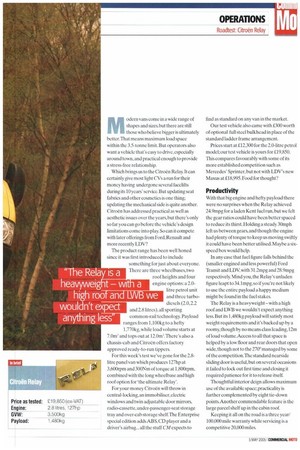M odern vans come in a wide range of shapes and
Page 45

If you've noticed an error in this article please click here to report it so we can fix it.
sizes,but there are still those who believe bigger is ultimately better.That means maximum load space within the 3.5-tonne limit. But operators also want a vehicle that's easy to drive, especially around town, and practical enough to provide a stress-free relationship.
Which brings us to the Citroen Relay. It can certainly give most light CVs a run for their money having undergone several facelifts during its 10 years' service. But updating seat fabrics and other cosmetics is one thing; updating the mechanical side is quite another. Citroen has addressed practical as well as aesthetic issues over the years, but there's only so far you can go before the vehicle's design limitations come into play. So can it compete with later offerings from Ford, Renault and more recently LDV?
The product range has been well honed since it was first introduced to include something for just about everyone. There are three wheelbases, two roof heights and four engine options: a 2.0litre petrol unit and three turbodiesels (2.0,2.2
high roo an LWB we
and 2.8 litres), all sporting common-rail technology. Payload ranges from 1,100kg to a hefty 1,770kg, while load volume starts at 7.0m3 and tops out at 12.0m3.There's also a chassis-cab and Citroen offers factory approved ready-to-run tippers.
For this week's test we've gone for the 2.8litre panel van which produces 127hp at 3,600rpm and 300Nm of torque at 1,800rpm, combined with the long wheelbase and high roof option for 'the ultimate Relay'.
For your money Citroen will throw in central-locking, an immobiliser,electric windows and twin adjustable door mirrors, radio-cassette, under-passenger-seat storage tray and over-cab storage shelf.The Enterprise special edition adds ABS, CD player and a driver's airbag... all the stuff CM expects to find as standard on any van in the market.
Our test vehicle also came with £300 worth of optional full steel bulkhead in place of the standard ladder frame arrangement.
Prices start at £12,300 for the 2.0-litre petrol model; our test vehicle is yours for .£19,850. This compares favourably with some of its more established competition such as Mercedes' Sprinter, but not with LDV's new Maxus at £18,995. Food for thought?
Productivity
With that big engine and hefty payload there were no surprises when the Relay achieved 24.9mpg for a laden Kent fuel run, but we felt the gear ratios could have been better spaced to reduce its thirst. Holding a steady 30mph left us between gears, and though the engine had plenty of torque to keep us moving swiftly it could have been better utilised. Maybe a sixspeed box would help.
In any case that fuel figure falls behind the (smaller engined and less powerful) Ford Transit and LDV, with 31.2mpg and 28.9mpg respectively. Mind you, the Relay's unladen figure leapt to 34.1mpg,so if you're not likely to use the entire payload a happy medium might be found in the fuel stakes.
The Relay is a heavyweight — with a high roof and LWB we wouldn't expect anything less. But its 1,480kg payload will satisfy most weight requirements and it's backed up by a roomy, though by no means class leading,12m of load volume.Access to all that space is helped by a low floor and rear doors that open wide, though not to the 270° managed by some of the competition.The standard nearside sliding door is useful, but on several occasions it failed to lock out first time and closing it required patience for it to release itself Thoughtful interior deign allows maximum use of the available space; practicality is further complemented by eight tie-down points.Another commendable feature is the large parcel shelf up in the cabin roof.
Keeping it all on the road is a three year/ 100,000 mile warranty while servicing is a competitive 20,000 miles.






































































































































































































